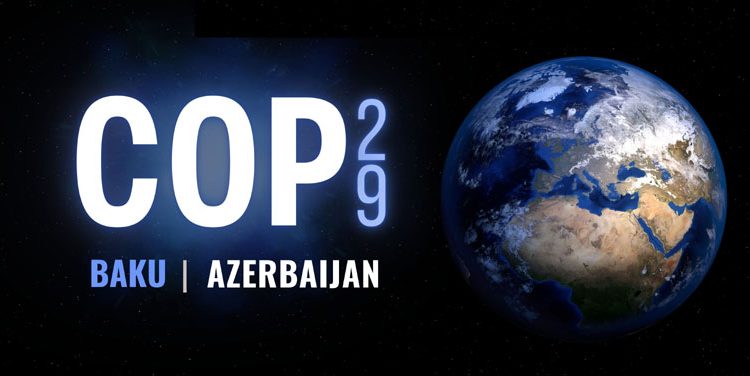Bibhuti Pati
Climate change and Global Warming will take precedence starting next week as global attention shifts to the 29th Conference of the Parties (COP29) to the United Nations Framework Convention on Climate Change (UNFCCC), scheduled to commence in Baku, Azerbaijan, on 11 November. Leaders from various nations will convene for discussions on climate issues, which are set to conclude on 22 November.
COP29 has been designated as the ‘Finance COP’ due to its focus on negotiations regarding the New Collective Quantified Goal (NCQG) for climate finance. This goal represents a target for climate financing that the signatory countries of the Paris Agreement are expected to agree upon, beginning with a baseline of $100 billion annually.
It is the responsibility of developed nations to devise a solution to the worsening emergency, specifically regarding the transfer of funds from affluent to less affluent countries to address climate change. They initially committed to providing $100 billion annually by 2020; however, this target was not met, and by 2022, developed nations claimed that it had been achieved. Currently, the demand has escalated significantly to $1 trillion per year, highlighting not only the intensifying crisis but also the disparity between commitments made and the actual needs.
This year’s COP is anticipated to be characterized by its emphasis on the financial obligations necessary to tackle the increasing effects of climate change, particularly for developing nations that are disproportionately affected by climate-related calamities.
The core issue revolves around negotiators confronting one of the most significant obstacles in tackling climate change: securing and allocating the essential financial resources required to fulfill global climate objectives. For many years, climate finance has been central to these discussions—characterized by a complex interplay of commitments, figures, and obligations. The terminology used is often technical, encompassing terms such as mitigation, adaptation, and loss and damage.
The situation is more complex than it appears. It involves redirecting financial resources from regions that have significantly contributed to global warming to those areas that are suffering the consequences despite not being responsible for the issue. The Intergovernmental Panel on Climate Change (IPCC) reports that individuals in developing nations are 15 times more likely to be affected by natural disasters compared to their counterparts in developed countries. In a global landscape grappling with substantial financial hurdles in the aftermath of disasters, numerous developing nations require increased support to address the impacts of climate change.
Climate finance is typically discussed within three overarching categories, each presenting its own complexities. The first category encompasses visible projects, such as investments in wind farms and solar panels. These initiatives not only yield financial returns but also result in significant reductions in emissions. Their clarity and direct benefits make them appealing to investors. Such programs, frequently highlighted in optimistic discussions at events like COP, contribute to the global shift towards renewable energy. However, the other categories, which involve less apparent costs, prove to be more challenging to address.
The second category, adaptation, focuses on resilience: preparing for the challenges that lie ahead. This includes constructing barriers and cultivating drought-resistant crops, all aimed at transforming lives to face a future that may seem far off. These initiatives should not be viewed merely as investments; rather, they represent calculated risks—an assumption that impending storms will not devastate entire communities. Notably, the most significant funding gaps exist within the realm of adaptation. This topic will be a subject of quiet yet urgent discussion at COP29, particularly regarding the amount of funding required and its sources.
The third category, however, stands out as the most contentious: loss and damage. This aspect does not pertain to mitigation or adaptation; rather, it focuses on compensation. It addresses the need to compensate those nations that, through no fault of their own, have suffered devastating losses due to climate change. Their lands have been degraded, ecosystems have been disrupted, and families have been displaced. How can one quantify such profound loss?
The Loss and Damage Fund is expected to be a focal point of contention at COP29, yet the figures are indisputable. Wealthy nations have yet to match these commitments. Following the fund’s establishment, several developed countries pledged over $420 million in voluntary contributions during the conference. To date, total commitments have increased to $661 million.
At the core of these discussions lies a persistent uncertainty: can the wealthiest nations muster the political resolve to honor their commitments? Alternatively, will they persist in relying on polished rhetoric, promises of future investments, and the encroachment of private equity in areas where government action is lacking? For developing nations, the need for solutions is immediate.
This is not merely abstract discourse; it is a matter of life and death. The impacts of climate change are already evident—rising sea levels, increased flooding, and prolonged droughts. In small island nations, entire ways of life are vanishing as swiftly as sand slipping through one’s fingers. In coastal urban areas, homes may become uninhabitable within a generation for any family.
The statistics are astonishing: $1 trillion each year. However, for individuals facing the challenges posed by climate change, the focus is not solely on the figure; it is fundamentally about survival. Solutions exist. Climate finance could be deployed through innovative mechanisms, including green bonds, sustainable credit, and advanced global partnerships. Additionally, institutions like the World Bank and the International Monetary Fund could revise their lending approaches to incorporate climate adaptation and resilience. Nevertheless, all these suggestions and potential solutions share an implicit truth: their effectiveness is moot if the necessary funding does not materialize.
The journey ahead is undoubtedly challenging; however, one certainty remains: climate finance is essential for facilitating significant climate action. Without it, the global community will struggle to meet its emission reduction targets and protect vulnerable populations from the adverse effects of climate change.
As COP29 concludes, it will follow the familiar pattern of speeches and agreements, accompanied by pledges for action. Yet, for those directly impacted by climate change, the pressing concern will be: when will these promises materialize? What about the funding? Where will these commitments be directed? At present, they observe the shifting tides and rising temperatures, clinging to the hope that the world will not abandon them.

No NCQUG means no COP29!
The NCQG is anticipated to be established by 2025 and serves as a continuation of the commitments made during COP15, which took place in Copenhagen in 2009. At that conference, developed nations pledged to provide $100 billion annually in climate finance to assist developing countries with their climate-related needs, drawing from a variety of funding sources, including public, private, and alternative avenues.
In 2021, during COP26 held in Glasgow, it was agreed that nations would establish a new climate finance target by 2025. Now, 15 years after the commitment to provide $100 billion annually, the NCQG is set to define a new financial objective, incorporating fresh sources and new contributors to climate funding. Nevertheless, despite over three years of discussions, uncertainties regarding the amount of funding, the contributors, and the intended beneficiaries of the NCQG remain unresolved ahead of COP29. In February of this year, India spearheaded a call for developed nations to provide $1 trillion annually for climate finance until 2030.
Additionally, reports from the UNFCCC and the Independent High-Level Expert Group on Climate Finance, established by the COP27 and COP28 Presidencies, indicate that developing countries require between $1 trillion and $2 trillion each year by 2030. The primary contention lies in developed nations advocating for an expanded pool of funders to include emerging economies such as China, while developing countries, including the G77 (a coalition of developing nations focused on advancing their economic interests), maintain that the financial responsibility should rest solely with developed countries.
During the Bonn Climate Change Conference held earlier this year, India, China, and Brazil—countries that are part of the G77—asserted that they ” It is not possible to advance beyond COP29, without a resolution regarding the NCQG.”

